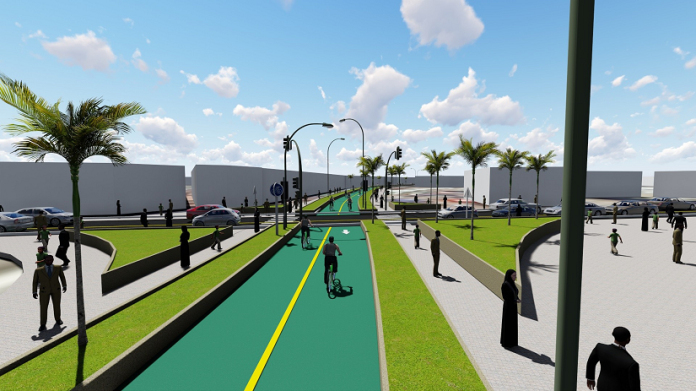From Paris to Kampala, the move to improve non-motorised local life is hastening and generating different approaches in different places.
More of a concept than a blueprint, the 15-minute city aims to provide people with all the basic amenities they need within 15 minutes of home – without getting in a car.
That concept can be quite open-ended. For example, while the focus is placed on walking and cycling, some urban authorities focus heavily on public transport as integral to their plans. The amenities in question can also vary. Vital services like schools and health centres are almost always part of the picture, but in many schemes a big focus is put on shops, cinemas and employment.
Even the ’15 minutes’ is flexible. WSP’s work in Aotearoa in New Zealand has focused on a 20-minute city plan. Those extra five minutes, however, still focus on the same goals – improving local life and reducing the heavy traffic caused by cities growing outwards from the conventional city centre. And that flexibility reflects what is really important – the change in how cities are run.
David Kidd of WSP explains: “It’s widely acknowledged that we can’t continue to build the way we have been. Our cities have largely been designed on the post-war principles of people living in suburbs commuting to work in a CBD by motor vehicle. With 70 years of urbanisation came densification and gridlocked cities. This necessitated a rethink in city planning.”
Diverse implementation
Looking at Aotearoa, the range of delivery tools available becomes very clear very quickly. As a comprehensive strategy, it includes planning measures for housing mixes within each neighbourhood, transitioning workplaces to local areas, localised open spaces, amenities and even integration of digital communications to better connect people.
There are less comprehensive approaches, however, and these are no less important to the urban design revolution underway. Take the Ugandan capital Kampala. While the city has not master-planned a 15-minute strategy, it has bold plans to transition towards non-motorised transport that would look exactly as one might expect of a 15-minute city.
One of its plans is for a 15km non-motorised corridor for pedestrians and cyclists along the Kampala–Namanve railway reserve. This pleasant environment for walking and cycling connects to 4km of existing pedestrianised streets within the Kampala business district, creating a whole new planning approach for the traffic-heavy city as its economy grows.
Then there is Paris, an early adopter of the 15-minute city concept. As a highly dense and heavily developed older city, many historic planning decisions have left barriers that make short distances into long journeys without a car.
That has seen Cable 1 proposed, a 4.5km cable car network calling at five stations and passing over urban barriers such as railway lines and a major highway to de-isolate several communities. This connects several poorer neighbourhoods quickly with facilities that otherwise take 40 minutes by bus. It also takes up little space in a dense urban environment as the 33 pylons have small footprints.
This diversity of approach is an asset. Professor Carlos Moreno, who coined the term 15-minute city and now advises the Mayor of Paris, explained: “We must be creative and imagine, propose and build another pace of life, other ways of occupying urban space to transform its use, in order to access essential urban social functions.”
Why now?
Many of the aspirations that 15-minute cities embody are not new. More sustainable and affordable transport, open spaces and access to amenities have been part of urban planning for a long time. So why has this new approach emerged now?
One reason is that urbanisation has grown too far and too fast to keep building the way cities did before. Accommodating more cars on city centre roads is just not possible as those cities grow outwards and upwards.
That has led to some radical responses. In the UK, where 100 town and city authorities have announced plans to become 15-minute cities, there have been moves to develop enforcement measures to support the change.
In Oxford, the city council has designated new Low Traffic Neighbourhoods across the whole city, and from 2024 it will have in place a series of filter systems that drivers will need a permit to pass through, with fines imposed for those without permits.
This has been made somewhat more possible than in past decades by high quality technology that allows accurate traffic monitoring. It has also been made more palatable for residents by the pandemic.
With millions more people now able to work within their communities – be it from home or at hubs – the opportunity to develop stronger communities and eliminate commutes is significant.
Dr Nelson Ogunshakin, CEO of the international engineering federation FIDIC, explained: “The 15-minute city wasn’t created for the pandemic, but it offers solutions and opportunities that are almost tailor-made for the post-pandemic world. People working from home instead of commuting to central business districts are spending more time in their neighbourhoods and for many who live in zones built for commuters, that has meant noticing more of what is and isn’t available.
“The drop in traffic during lockdowns also demonstrated the potential for extensive reductions in pollution and journey times. As people consider alternative transport mobility arrangements and took to cycling and walking, many previously unnoticed barriers that turn short distances into long journeys became apparent within communities. Against that backdrop, the opportunity and demand for greater localism and innovative projects has never been greater.”


















